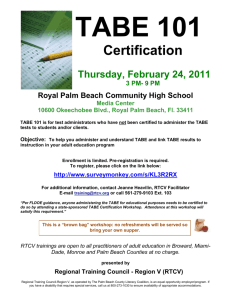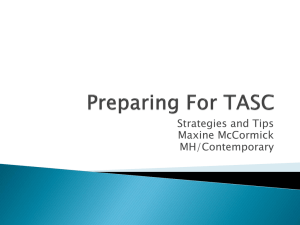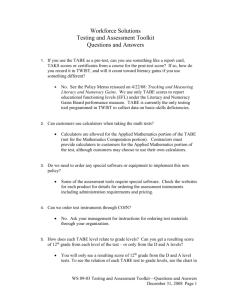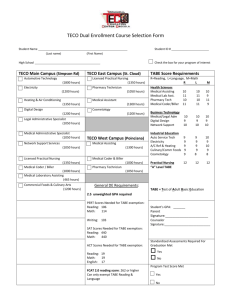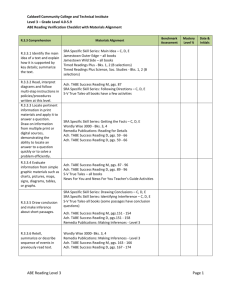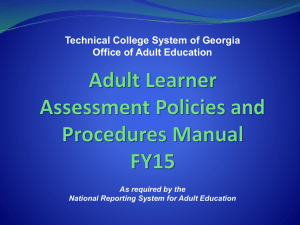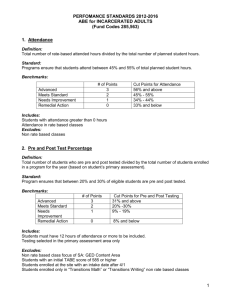Using the TABE to Assess Basic Skills Proficiency
advertisement
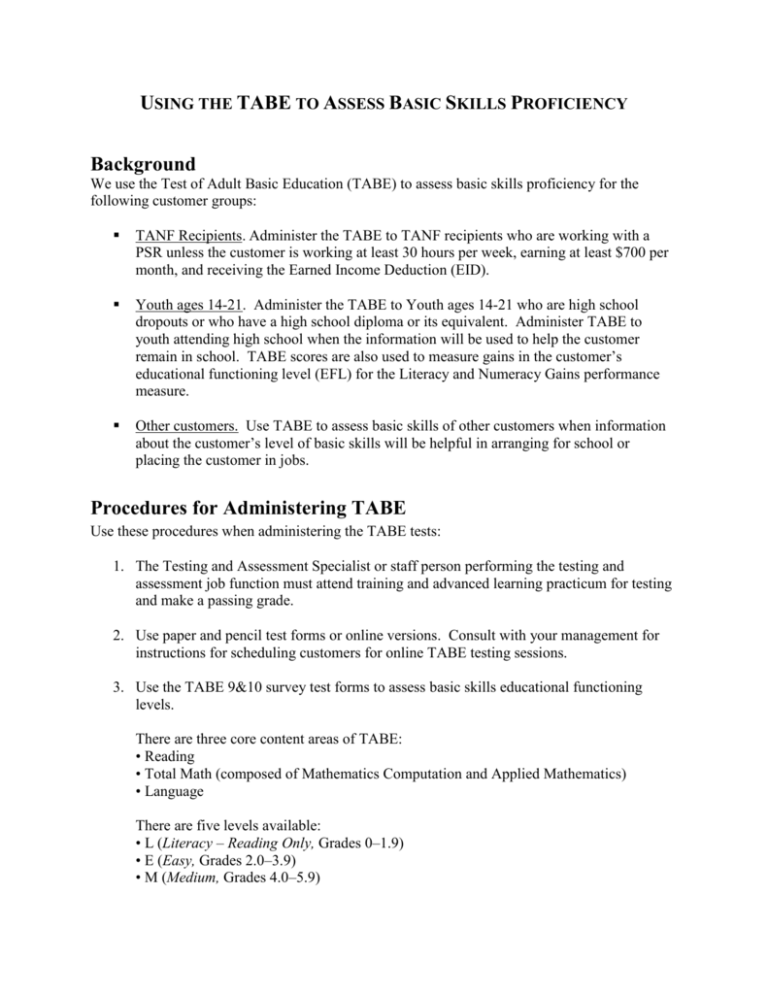
USING THE TABE TO ASSESS BASIC SKILLS PROFICIENCY Background We use the Test of Adult Basic Education (TABE) to assess basic skills proficiency for the following customer groups: TANF Recipients. Administer the TABE to TANF recipients who are working with a PSR unless the customer is working at least 30 hours per week, earning at least $700 per month, and receiving the Earned Income Deduction (EID). Youth ages 14-21. Administer the TABE to Youth ages 14-21 who are high school dropouts or who have a high school diploma or its equivalent. Administer TABE to youth attending high school when the information will be used to help the customer remain in school. TABE scores are also used to measure gains in the customer’s educational functioning level (EFL) for the Literacy and Numeracy Gains performance measure. Other customers. Use TABE to assess basic skills of other customers when information about the customer’s level of basic skills will be helpful in arranging for school or placing the customer in jobs. Procedures for Administering TABE Use these procedures when administering the TABE tests: 1. The Testing and Assessment Specialist or staff person performing the testing and assessment job function must attend training and advanced learning practicum for testing and make a passing grade. 2. Use paper and pencil test forms or online versions. Consult with your management for instructions for scheduling customers for online TABE testing sessions. 3. Use the TABE 9&10 survey test forms to assess basic skills educational functioning levels. There are three core content areas of TABE: • Reading • Total Math (composed of Mathematics Computation and Applied Mathematics) • Language There are five levels available: • L (Literacy – Reading Only, Grades 0–1.9) • E (Easy, Grades 2.0–3.9) • M (Medium, Grades 4.0–5.9) • D (Difficult, Grades 6.0–8.9) • A (Advanced, Grades 9.0–12.9) 4. Administer the Locator assessment and consult the chart below to determine the appropriate TABE level to administer. TABE LEVEL TO ADMINISTER* E LOCATOR ASSESSMENT SCORES EVALUATION CHART READING MATHEMATICS # CORRECT # CORRECT LANGUAGE # CORRECT TABE 9&10: 4–5 TABE 9&10: 6 and below M TABE 9&10: 6 and below TABE 9&10: 7–8 TABE 9&10: 7–8 TABE 9&10: 7–8 D TABE 9&10: 9–10 TABE 9&10: 9–11 TABE 9&10: 9–10 A TABE 9&10: 11–12 TABE 9&10: 12–16 TABE 9&10: 11–12 *Note: Administer the TABE Level L (Literacy – Reading Only) for customers who identify themselves as nonreaders or when staff believe the customer will have significant difficulty with Level E. 5. Once you determine the appropriate level, administer the Survey form (for Reading, Mathematics and Language) to the customer. If a customer has been approved for accommodations because of a disability, these same accommodations apply to the preand post-TABE assessment. 6. All levels (L, E, M, D, A) are calibrated on the same scale, therefore, scale score results and grade levels can be compared across levels. Example: If the Locator assessment places a customer at Level E, the customer should be pre-tested with Level E, Form 9 and then post-tested with: • Level E, Form 10, if customer demonstrates minimal progress within his or her period of participation; or • Level M, Form 9, if customer demonstrates significant progress within his or her period of participation. Note: Forms and levels of the test must be alternated accordingly. 7. The Mathematics Computation and Applied Mathematics sub-tests must be used together to yield a Total Mathematics score. To compute a Total Mathematics score, the youth must take the same form and level of both the Mathematics Computation test and the Applied Mathematics test. 8. Out-of-school youth determined to be deficient in basic skills must be post-tested at least once prior to the one-year anniversary date of the youth’s first WIA youth funded service, or at exit (whichever is earlier), to determine whether the youth made an EFL gain. Expanded Services Standard VII. Information Resources for Staff A.1. Using TABE to Assess Basic Skills Reissued: May 7, 2009 Page 2 of 4 9. You may be asked to prescreen customers and refer only those meeting certain criteria (i.e. scoring 9th grade or higher on the D Level test). Follow the normal test instructions and administer the Locator test first. If the Locator test shows the customer will need to be tested using the E or M level Survey, then the customer does not meet the referral criteria. There is no need to administer the D Level test. Tracking Assessment Service in TWIST Record the assessment service each time the customer is pre or posted with TABE. Tracking assessment ensures the scores are included in the common measures for the appropriate performance period. Enter the Service Category 2-Assessment/Case Management and enter Service code 8Comprehensive Objective Assessment. Assessment is a one-day service. Enter the start and planned end dates to occur on the same date. Recording TABE Scores in TWIST Enter scale scores, not grade equivalency levels, in TWIST within 24 hours of test completion. The scale score is the primary score for TABE and is used to compute and derive all other scores, including grade levels. Steps for recording TABE scale scores in TWIST: 1. From Menu Selections, select Assessment to access the Testing tab. 2. In the Testing screen, right click to Add a new test record. The test detail screen will open. 3. Enter the Test Date. 4. From the Pre/Post dropdown menu select the appropriate category. Select options 3Refused Testing or 6-Unable to Test when appropriate and document the justification in Counselor Notes. Customers who Refused Testing or who were Unable to Test are not excluded from the literacy and numeracy gains measures. 5. From the Category dropdown menu, select “ABE”. 6. From the Test dropdown menu, select the appropriate test administered. Note: The TABE Form field is only applicable when TABE 7-8, 9-10 has been selected. 7. Select the appropriate Functional Area. 8. Select the appropriate TABE Form. Expanded Services Standard VII. Information Resources for Staff A.1. Using TABE to Assess Basic Skills Reissued: May 7, 2009 Page 3 of 4 9. Enter the Scale Score. The Grade Level and EFL will automatically compute and populate once the Scale Score is entered. 10. Click the OK button. Testing Customers Who Have Disabilities When administering the TABE to a customer who has a disability, Workforce Solutions staff will provide reasonable accommodations, as appropriate. Reasonable accommodations may include: 1. A change to the method of presenting the TABE. For example: providing Braille versions of the test, or orally reading the directions or test questions to test-takers; 2. A change to the method of response to the test questions. For example: having the testtaker point to a response or use a computer for responding; 3. A change to the setting in which the test is provided. For example: permitting the test to be taken at home, or in small groups, rather than in a large-group or institutional setting; and 4. A change to the timing/scheduling of the test. For example: extending the amount of time generally provided for completion of the test or permitting frequent breaks. Using the appropriate test combined with appropriate accommodations or modifications, helps us provide a valid and reliable evaluation of the customer’s knowledge, skills, abilities, and/or interests. If the nature or extent of a particular customer’s disability, or the limitations of the test itself, prevent the test from providing a valid or reliable evaluation in a particular case, an alternate test or assessment tool must be offered. Filing Test Information File the TABE test forms and/or printouts of the TABE test answers and scores in the customer’s paper file. If the customer has a disability and was provided with accommodations for the testing/assessment process, the test results must be stored in a separate file, apart from any other information about the customer, and access to the results must be limited, as we do for all medical or disability-related information about a particular individual. Expanded Services Standard VII. Information Resources for Staff A.1. Using TABE to Assess Basic Skills Reissued: May 7, 2009 Page 4 of 4
